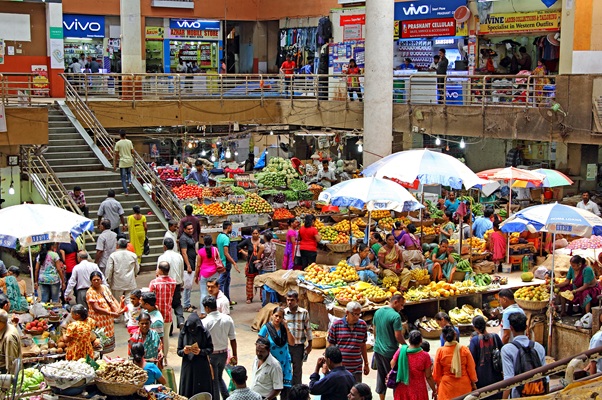.png)

Groupthink is the House View of BasisPoint’s in-house columnists.
April 17, 2025 at 10:02 AM IST
India wrapped up the last financial year on a relatively solid footing, with several high-frequency indicators showing a pick-up in March. Activity in the real economy gained pace despite mounting risks from a hostile global environment, particularly escalating trade tensions led by the United States.
The most significant threat came from Washington's tariff offensive, spearheaded by President Donald Trump, who has now imposed sweeping reciprocal duties on most trading partners. While a 90-day pause for countries other than China helped ease financial volatility in April, the broader trajectory remains uncertain. With US tariffs on Chinese goods now as high as 245%, fears of a sharp global slowdown are no longer remote. India may be insulated in the near term, but the knock-on effects are bound to surface.
The Reserve Bank of India has already trimmed its GDP forecast for 2025-26 to 6.5% from 6.7%, even as many analysts argue that this remains optimistic. In that context, March’s data may be less a turning point and more of a final spurt before the external drag kicks in.
Late Surge
March ended on a high note for government revenue and broader trade activity. Goods and services tax collections jumped 9.9% year-on-year to ₹1.96 trillion, the second-highest monthly figure ever. E-way bill generation, a proxy for domestic movement of goods, surged 20.2% to a record 124.5 million, posting the third-fastest growth rate in over two years.
Electricity generation also edged up, growing 4.7% annually in March, the strongest showing in eight months. Total generation hit 136.1 billion kWh, the fourth highest monthly reading ever.
Business sentiment remained resilient. The manufacturing purchasing managers' index rose to 58.1, a new eight-month high. Though the services PMI eased slightly, the composite index climbed to 59.5—its best since August.
Vehicle sales gave a more nuanced reading. Passenger vehicle despatches rose just 3.7% to 329,742 units, in line with a sluggish trend for the year. Full-year sales rose only 2% to 4.3 million units, pointing to persistent weakness in urban discretionary demand.
Two-wheelers, on the other hand, told a different story. Domestic sales grew 11.4% in March to 1.66 million units—the fastest pace in five months—and ended the year with 9.1% growth at 19.6 million units. The divergence suggests rural consumption, typically more sensitive to cost and fuel trends, is outpacing urban demand.
Tractor sales in March continued to be robust. Domestic sales rose 25.4% on year to 79,946 units in March. The sharp growth is partly on account of a low base effect. Nonetheless, the divergence in passenger vehicle and tractor and two-wheeler sales probably reflects the state of urban and rural demand in the country.
Export Spike
India’s merchandise exports rose for the first time in five months in March, expanding 0.7% to $41.97 billion. Much of this appears to be a front-loading of shipments ahead of US tariffs. Exports to the United States surged 35.1% to $10.15 billion, boosting the overall figure to the third-highest monthly print on record. Imports also rose sharply by 11.4% to $63.51 billion, though this was largely a base effect. The resulting merchandise trade deficit widened to $21.84 billion—above comfort levels, but below the 2024-25 monthly average of $23.57 billion.
Inflation finally offered some respite. Headline consumer price inflation cooled to 3.34% in March, the lowest in five and a half years, aided by a plunge in vegetable prices. Wholesale inflation also moderated to 2.05%, a six-month low.
Lower crude oil prices helped. The Indian crude basket averaged $68.48 per barrel in April—down 5.5% from March’s $72.47—thanks to a risk-off global environment. Yet the benefits haven’t fully passed through to consumers. The government raised excise duty on petrol and diesel by ₹2 per litre, offsetting some of the global relief. State-run oil marketing companies absorbed the hike, keeping pump prices unchanged.
Liquidity Flip
In financial markets, liquidity conditions improved sharply in April. The Reserve Bank injected liquidity through open market operations, long-term repo operations, and foreign exchange swaps. The average banking system liquidity flipped from a ₹1.33 trillion deficit in March to a surplus of ₹1.66 trillion so far in April.
Equity markets responded positively. The Nifty 50 index rebounded 6.3% in March after five straight months of decline. The index has held steady in April despite lingering geopolitical jitters. In the bond market, yields continued to fall. The benchmark 10-year government bond yield touched a multi-year low of 6.37%, aided by easier liquidity and the RBI’s 50-basis point rate cuts since February.
While the current backdrop may look constructive, it would be premature to extrapolate March’s momentum into the rest of the year. Global headwinds are gathering speed. With the full impact of protectionist trade measures yet to transmit through global value chains, India’s export resilience could fade quickly. Weakness in advanced economies, tighter financial conditions globally, and the potential for oil price volatility all pose challenges to sustaining growth.
Domestically, a slowdown in investment appetite and the tentative nature of urban consumption could weigh on quarterly GDP prints. High-frequency indicators may remain buoyant in the early months of 2025-26, but the second half of the year could look very different.
For now, the numbers paint a reassuring picture. The task for policymakers will be to sustain the domestic cycle while staying nimble enough to adjust to external shocks. The RBI’s early pivot to accommodation may prove prescient—but only if supported by prudent fiscal management and policy flexibility.
India’s economy may have ended the financial year on a strong note, but the hard part is just beginning.




